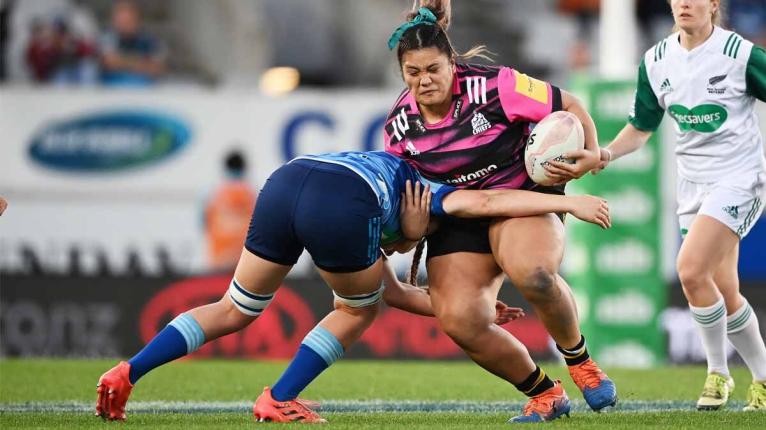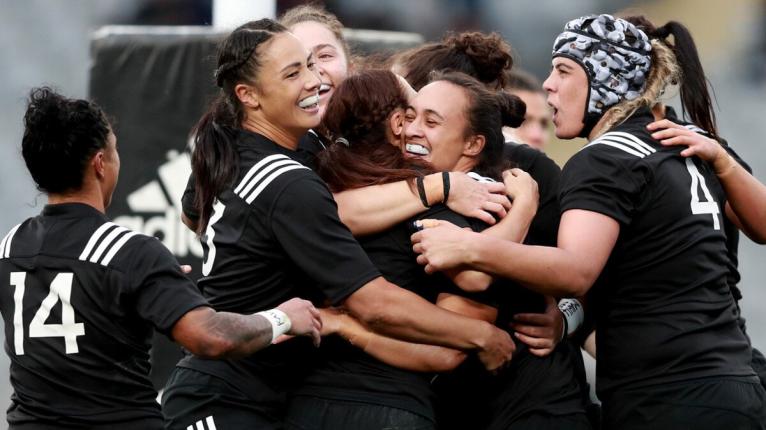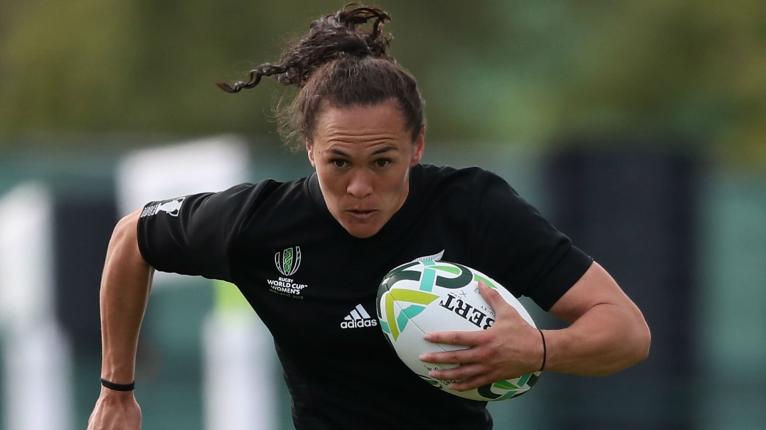For as long as the sport has been played in New Zealand, countless Kiwi women have loved and participated in rugby — but New Zealand Rugby hasn’t always loved them back.
And, while times have indeed changed, it is clear that the national union has not changed its culture and structures fast enough.
Consider two examples of their organisational decision-making from the last six months: their exceedingly lenient disciplinary treatment of All Blacks flanker Shannon Frizell after two charges of male assaults female (now dismissed, following his completion of a diversion scheme), and their failure to pay Blues and Chiefs players for their involvement in the country’s inaugural Women’s Super Rugby fixture.
Taken together, they are evidence of a body that still appears institutionally incapable of treating women with the basic respect they deserve — both on and off the field.
The next twelve, however, will provide NZR with the opportunity to enact a step change.

In March 2022, Super Rugby Aupiki will pick up where this season’s one-off fixture left off and commence as a four-team, four-round competition — with 28-player squads assembling for four days each week, and being compensated for their labour.
Then, in October, the 15-a-side World Cup which was originally scheduled for 2021 will finally kick off at Eden Park, providing the union with an unmissable opportunity to promote and celebrate the women’s game.
The Black Ferns, of course, will be seeking to retain their status as world champions on home soil next year — but the disintegration of more than a season’s worth of fixtures as a consequence of the pandemic means that Glenn Moore’s side are much less settled than you might expect 12 months out from the tournament.
For that reason, their ongoing tour of England and France — with a series of four tests kicking off at Sandy Park this Sunday — will take on even more importance than it might have done in normal circumstances.
Since losing to the Black Ferns in the 2017 final in Belfast, England have played 34 tests … In contrast, the Black Ferns have played only 11 international matches since regaining the world title.
The recent addition of the World Rugby Pacific Four series to their 2022 schedule will have been welcomed, but New Zealand will still go into the World Cup having played considerably fewer tests than their European rivals over the course of the five-year cycle between tournaments.
Since losing to the Black Ferns in the 2017 final in Belfast, England have played 34 tests. Over the same period, the French women’s team has played 29.
In contrast, the Black Ferns have played only 11 international matches since regaining the world title.
The last time the leading nations from each continent came together to play one another — at the 2019 Super Series in San Diego — New Zealand did manage to come out on top.

Crucially, however, their opponents will have continued to build cohesion since that point in time. Barring a pair of non-test fixtures against a Barbarians side last November, Moore’s team’s development over this period has been limited to a series of training camps across Aotearoa.
In addition, Moore’s squad for this end-of-year tour has a slightly different make-up to the playing groups he has been able to put together for recent major tournaments.
Where the squads for the World Cup and Super Series each had a core of players at their athletic peak, the ages of players in this group are more dispersed — towards both ends of the spectrum.
While 16 of the 28 who went to Ireland in 2017 — and 13 of the 32 selected for San Diego — were between 26 and 31 years old, only 10 of the 34 players selected this time around fall into that bracket.
 Despite this identifiable trend, there remains a strong, reliable spine to Moore’s likely first-choice team for this upcoming set of fixtures.
Despite this identifiable trend, there remains a strong, reliable spine to Moore’s likely first-choice team for this upcoming set of fixtures.
In the forwards, Pip Love (7 starts), Te Kura Ngata-Aerengamate (7), Aleisha-Pearl Nelson (8), Eloise Blackwell (13) and Les Elder (10) have all started more than half of the Ferns’ 13 fixtures since 2017; in the backline, Kendra Cocksedge (13), Ruahei Demant (12), Ayesha Leti-I’iga (9), Chelsea Alley (8) and Renee Wickliffe (11) all reach the same mark.
But the distribution of ages in their wider squad does nonetheless neatly frame a question that the head coach will face repeatedly as he selects around that spine: does he choose to trust the track records of those with more experience under their belts, or put his faith in up-and-coming talent?
Given the lack of time the team has spent together at international level in recent years, time spent together in other contexts will take on more importance.
In the pack, counter-intuitively, youth may in fact be the safer call.
Given the lack of time the team has spent together at international level in recent years, time spent together in other contexts will take on more importance.
With that in mind, the existing relationship between Blackwell and her frequent partner in the Auckland second row — 20-year-old test rookie Maiakawanakaulani Roos, who adds a lot of value at the lineout — could help accelerate the team’s development over the next month.
Of the 11 career starts at lock Roos has made in the FPC since her 2019 debut, 10 have come next to Blackwell, with the pair starting together for the Blues in their Women’s Super Rugby fixture in May too.
Their Storm teammate Liana Mikaele-Tu’u — already a powerful, skilled ball-carrier at only 19 — could equally be called upon to fill one of the slots next to captain Elder in the back row.
The Hawke’s Bay native — whose brother Marino plays Super Rugby for the Highlanders — has made nine FPC starts in the back row since moving to the capital at the beginning of 2020, with seven coming alongside a locking combination of Blackwell and Roos.

Looking ahead to next year, the possibility of reintegrating Auckland loose forward Charmaine McMenamin (unavailable for this tour, but an international veteran) into a pack with strong existing links to her province could make these superficially risky selections even more appealing to Moore from a cohesion perspective.
In the backline, however, it may make more sense for the selectors to lean in the opposite direction — and draw on some existing relationships built in another format of the sport.
Moore has named in his group for the tour three players who won gold in the sevens tournament at the Tokyo Olympics this summer.
While the Black Ferns Sevens side also saw their regular fixture schedule upended by Covid-19, Kelly Brazier, Stacey Fluhler and Portia Woodman have still spent more time playing together in elite competition in recent months than most of the other options in the 15-a-side squad they have now joined.
In Japan, they helped their team to play an incisive brand of ball-in-hand rugby, with New Zealand’s tally of 4.7 tries per game in the competition comfortably the highest of any nation.

Unsurprisingly, the success of this approach hinged on the ability of the Kiwi women to execute their basic skills effectively.
Across the tournament, New Zealand passed the ball more frequently — 1.85 times for every carry they completed — than every other team except Japan (2.01 passes per carry), while turning the ball over much less frequently than the average side. They conceded a turnover just once every 7.9 carries completed, compared to a competition-average rate of once every 6.3 carries.
The rate at which they retained their own possession was also far ahead of any nation, winning 96 per cent of their attacking rucks compared to a competition average of 87 per cent.
These skills, of course, must be utilised in the 15-a-side game in a context that can often look markedly different to sevens. But, if Moore wants his team to play with width and speed, then selecting for crisp handling and efficient breakdown work — which these statistics suggest his sevens stars would bring — would be a good place to start.
It’s worth noting also that Brazier, Fluhler and Woodman do have prior experience playing together in the longer format of the sport, with the trio having started for the Black Ferns at 12, 13 and 14 respectively during the run to the 2017 World Cup Final.
Despite Woodman’s lack of game-time — she has not played a test since lifting the trophy in Belfast — it would be surprising if the athletic point of difference she offers did not edge out either Leti-I’iga or Wickliffe for one of the wing slots, as impressive as both have been for the team in her absence.
Of the three, Fluhler looks the most certain to slot straight into the starting XV. Her five test starts at outside centre during the team’s 2018 campaign — and her recent experience playing with Alley in the midfield for Waikato — should put her in pole position to reprise that role.
Despite Woodman’s lack of game-time — she has not played a test since lifting the trophy in Belfast — it would be surprising if the athletic point of difference she offers did not edge out either Leti-I’iga or Wickliffe for one of the wing slots, as impressive as both have been for the team in her absence.
Brazier, in contrast, may come under the most pressure from the squad’s new faces. Alley’s constant presence at 12 in recent seasons is likely to push her to fullback in search of a starting role — a position she filled against England during the 2019 Super Series.
There, she will run into competition with 21-year-old Renee Holmes and 18-year-old Patricia Maliepo — the supremely gifted Auckland playmaker who is listed in the squad as a first five-eighth, but has experience at provincial level in a number of positions.
Both have existing relationships with other players likely to start in the backline — Holmes with her Waikato teammates in midfield, and Maliepo with Auckland first five Demant — and so can’t be discounted from Moore’s plans entirely, despite their youth.

Nonetheless, Brazier’s general understanding of the game — and specific understanding of the tendencies of her more illustrious short-format teammates — may make her difficult to leave out.
In the short term, it is of course a positive for the coaching team to have these quandaries — to have elite professional athletes effectively seconded to their semi-professional programme to compete for key positions ahead of a crucial campaign.
By the time the next World Cup comes around, however, whoever is in charge of the Black Ferns will surely want more stable foundations to have been put in place in the 15-a-side game. In a world where fully professional national teams in both formats are on equal footing — and 15-a-side players are given the opportunity to devote the entirety of their professional lives to their craft — such movements between squads would significantly diminish in importance.
But those are not things the Black Ferns can put in place for themselves — regardless of how this European tour and next year’s World Cup go.
For the next four weeks, it will be the players in the spotlight. After that, it’s down to New Zealand Rugby to step up.


Comments
Join free and tell us what you really think!
Sign up for free